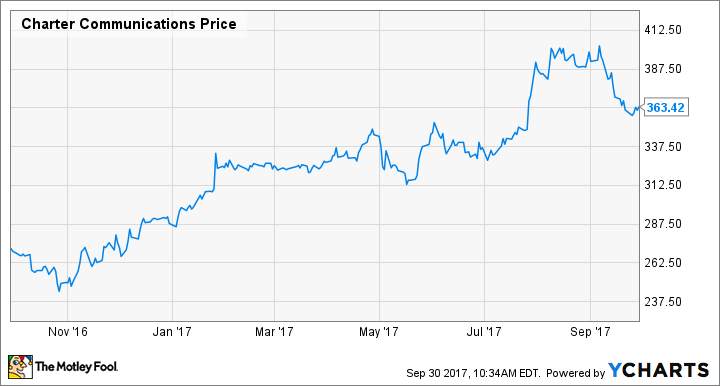Since it closed on its purchases of Time Warner Cable and Bright House in May 2016, Charter Communications (CHTR -2.12%) has seen its share price move mostly steadily higher.
That changed recently, when shares dipped on news that cord-cutting may have accelerated. So far, consumers have been abandoning traditional pay-television services in a trickle, not a flood, but it appears the exodus may be speeding up.
Charter, for example, lost 76,000 cable subscribers in Q2 2017, less than the 89,000 it lost in Q1, according to data from Leichtman Research Group (LRG). Those losses, which total 165,000 in six months, aren't far off from the 187,000 the company lost in all of 2016, and they're dramatically worse than the 54,000 subscribers the then-separate Charter and Time Warner jointly added in 2015.
Like the rest of the pay-TV industry, Charter may have a cord-cutting problem. Unlike its chief rival, Comcast (CMCSA -5.82%), however, Charter may lack the tools to fight it.
Image source: YCharts.
Cord cutting could get worse
In addition to owning its cable and broadband subscription business, Comcast owns NBC as well as a movie studio, and numerous cable channels. That gives the company a significant amount of content it can leverage on streaming platforms. In addition, Comcast has a stake in Hulu giving it a powerful, non-cable platform.
Charter has no similar hedge against cord-cutting. It does not own any content beyond its regional sports networks and if more people decide to drop cable, the company won't have a way to make back a portion of the lost revenue through licensing or streaming.
| Year | Pay TV Gains/Losses | Internet Gains |
|---|---|---|
| 2012 | 170,000 | 2,000,000 |
| 2013 | (105,000) | 2,600,000 |
| 2014 | (125,000) | 3,000,000 |
| 2015 | (385,000) | 3,100,000 |
| 2016 | (795,000) | 2,700,000 |
| 2017 (through two quarters) | (1,065,000) | 1,190,000 |
Data source: LRG.
Broadband demand could peak
The gain in broadband internet customers has more than offset any losses the pay-television industry. has experienced. That benefit has been a specific boon for cable companies, as they have posted gains while pay-TV providers using telephone-based technology have actually lost broadband users.
In 2016, Charter added 1.6 million broadband customers, more than even Comcast's 1.3 million. Charter also added another 458,000 internet subscribers in Q1 2017 and 267,000 more in Q2, again beating Comcast both times.
In the short term, these additions should continue to offset cord-cutting losses. In the longer term, Charter is vulnerable to two things. First, at some point, demand for broadband will peak. That may not happen anytime soon, especially because cable companies should continue to be able to win over customers from the inferior technology telco-based providers use.
A bigger threat may be a new player emerging in the broadband space. That could mean wireless carriers launching 5G networks, or it might be a technology currently being developed. It's possible, even probable, that new methods for delivering high-speed internet will emerge, and that could slow, or even end, Charter's growth.

The cable industry has been losing customers. Image source: Getty Images.
What's next for Charter?
Charter's key product -- cable television -- faces significant market headwinds. Cord-cutting has sped up, and it's probably going to become more common simply because the alternatives to paying the high cost of cable keep getting better.
That's something Charter really has no protection against. Its customer base in cable will shrink, but its overall user base will keep growing as long as the status quo remains in the broadband space.
In reality, Charter has been built on two pillars -- one starting to get a little wobbly, and one that remains strong. The company can bear the continued weakening of its cable pillar, but if the weakness spreads to its broadband business, Charter could find itself as a slowly decaying legacy business. That day isn't here yet, but it's not inconceivable that it's coming.





